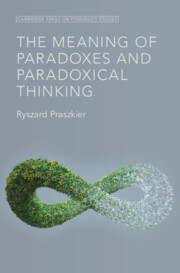Book contents
- The Meaning of Paradoxes and Paradoxical Thinking
- Cambridge series on possibility studies
- The Meaning of Paradoxes and Paradoxical Thinking
- Copyright page
- Contents
- Figures
- Tables
- Acknowledgments
- Introduction
- Part 1 Paradoxes and What They Do to Us
- Part II Sudden Unexpected Changes
- Part III Challenging the Impossible
- Part IV Peace and Its Challenges
- Part V Paradoxes and Creativity
- Introduction
- Chapter 12 Generating New and Useful Ideas
- Chapter 13 Brain Plasticity
- Chapter 14 Avenues for Enhancing Neuroplasticity
- Discussion and Summary
- Part VI Paradoxes in Action
- References
- Index
Chapter 14 - Avenues for Enhancing Neuroplasticity
from Part V - Paradoxes and Creativity
Published online by Cambridge University Press: 04 April 2025
- The Meaning of Paradoxes and Paradoxical Thinking
- Cambridge series on possibility studies
- The Meaning of Paradoxes and Paradoxical Thinking
- Copyright page
- Contents
- Figures
- Tables
- Acknowledgments
- Introduction
- Part 1 Paradoxes and What They Do to Us
- Part II Sudden Unexpected Changes
- Part III Challenging the Impossible
- Part IV Peace and Its Challenges
- Part V Paradoxes and Creativity
- Introduction
- Chapter 12 Generating New and Useful Ideas
- Chapter 13 Brain Plasticity
- Chapter 14 Avenues for Enhancing Neuroplasticity
- Discussion and Summary
- Part VI Paradoxes in Action
- References
- Index
Summary
Opening the mind to paradoxes and paradoxical thinking requires a malleable and plastic brain. The brain can be influenced by various factors, such as rehabilitation, physical exercise, and noninvasive transcranial brain stimulation; combining these interventions can have a synergistic impact on inducing neuroplasticity. The Feldenkrais approach uses atypical yet gentle and mindful sets of movements to expand the range of motion in a balanced way. This is done through augmenting neuroplasticity and new neuronal pathways related to the new movements. The Feldenkrais approach is used for enhancing the neuroplasticity and, consequently, creativity of an individual’s mind. It was also found that creating metaphors activates parts of brain that involve flexible imagination. In research metaphors were used to spark divergent thinking. The subjects of a study encompassing global creative people, above all, enjoyed discovering and innovating. When asked to choose from a list of what life experience delivers the most pleasure, the answer most frequently chosen was “designing or discovering something new.” They simply enjoy discovering and creating above all else. Joy plays a key role in boosting creativity. The influence of dancing on enhancing the brain’s structural and functional capacities has been documented in several studies.
Keywords
- Type
- Chapter
- Information
- The Meaning of Paradoxes and Paradoxical Thinking , pp. 107 - 112Publisher: Cambridge University PressPrint publication year: 2025

